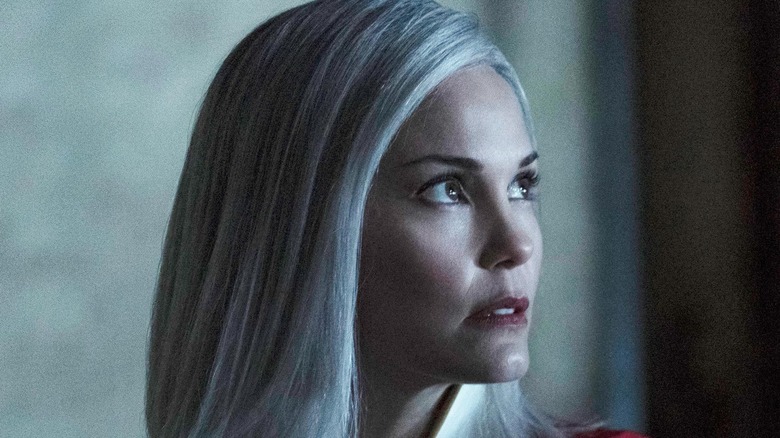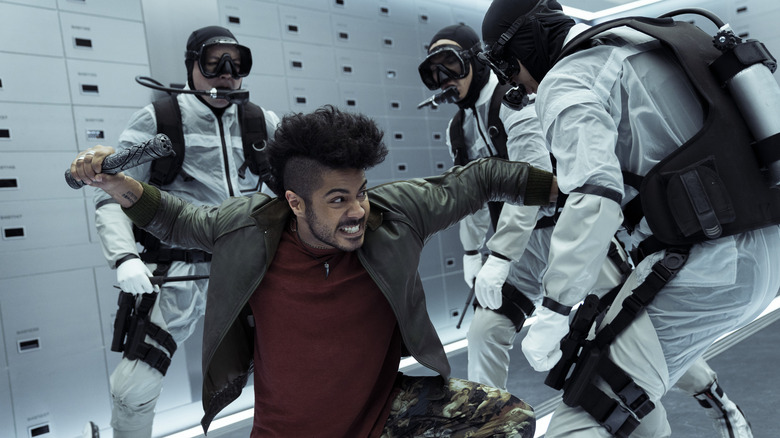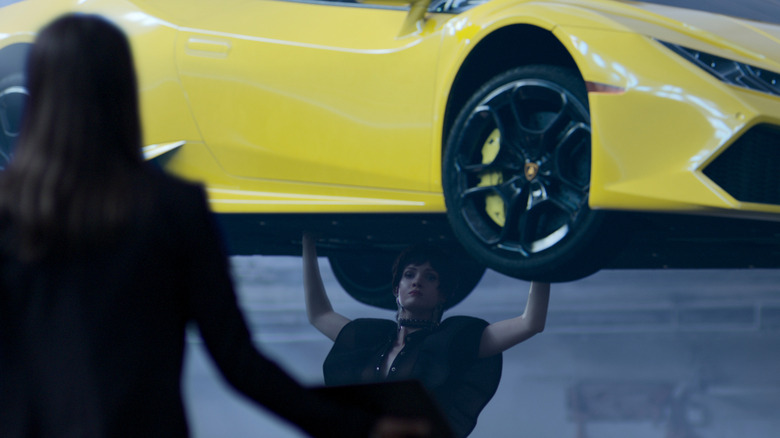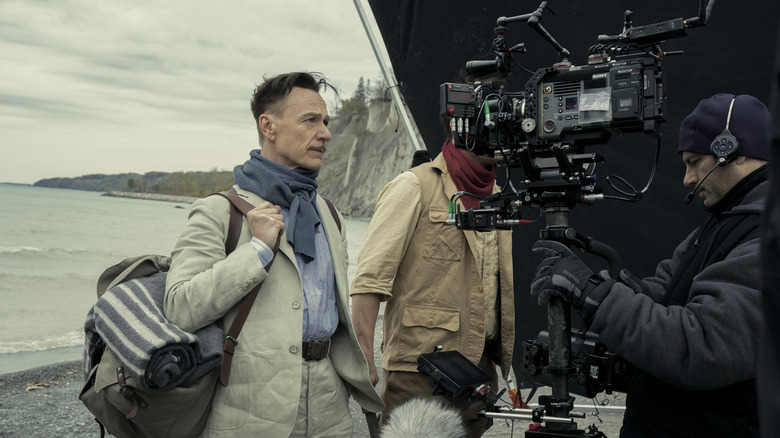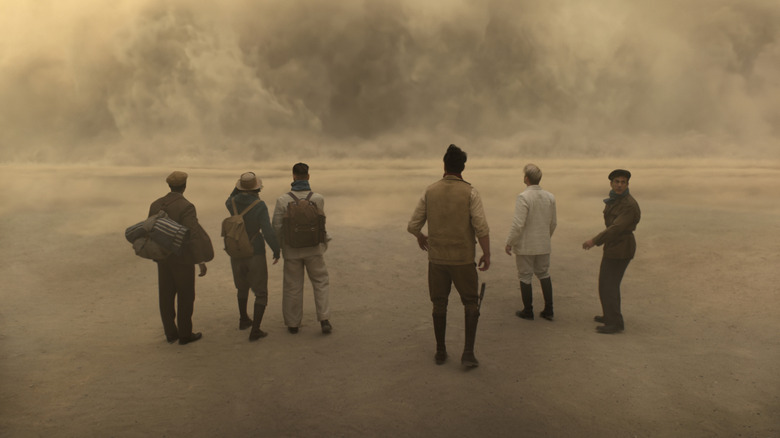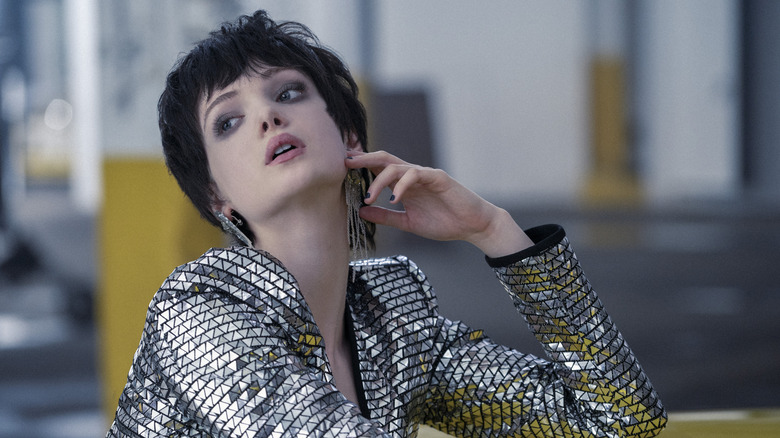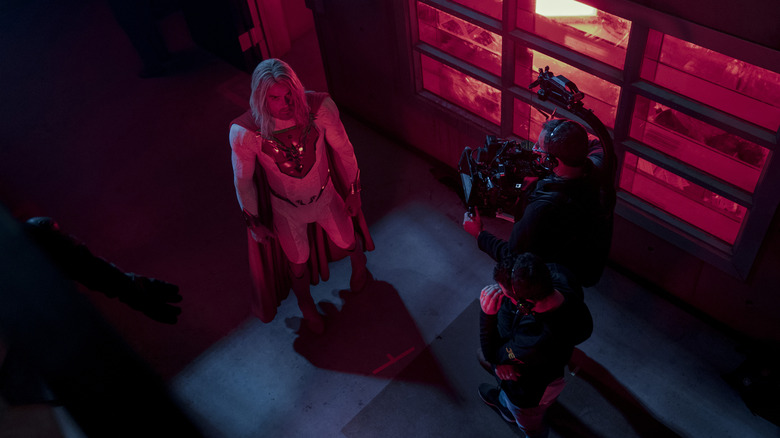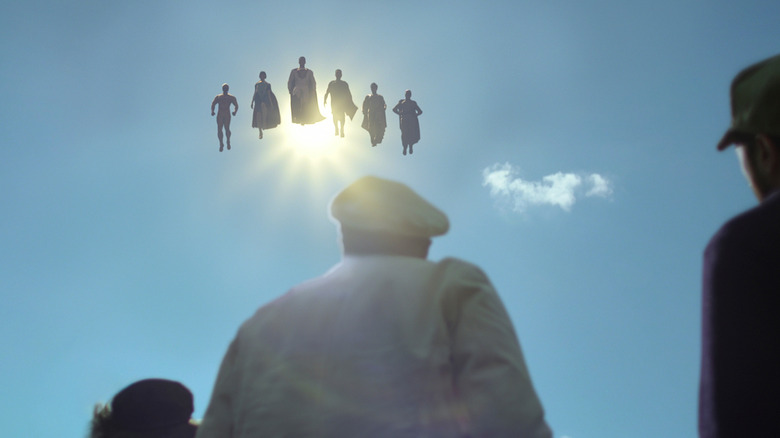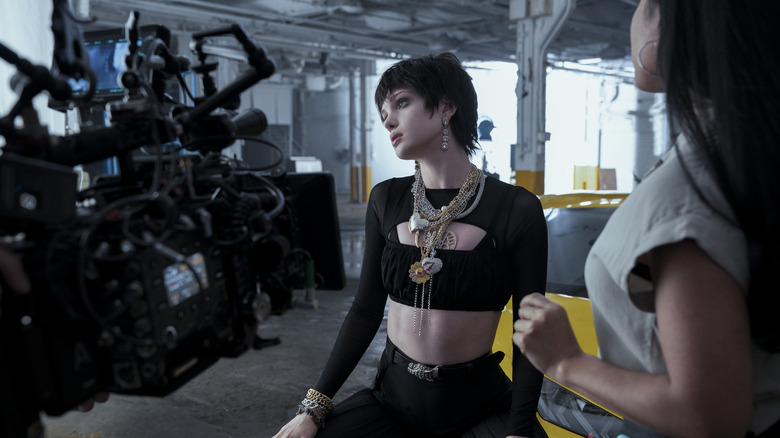Cinematographer Nicole Hirsch Whitaker Reveals How Those Epic Jupiter's Legacy Scenes Were Really Shot - Exclusive Interview
"Jupiter's Legacy" has been a smash hit for Netflix. Based on the comics by Mark Millar, and adapted in part by Marvel Netflix alum Steve S. DeKnight, the show is clearly resonating with audiences. Part of that is the cinematography, which captures the grandeur of being a hero with the cramped domestic life of people who desperately try to be normal — and Nicole Hirsch Whitaker, who was the director of photography for episodes 3, 4, 7, and 8, was a big part of that. She oversaw some of the most critical scenes in the show, from Chloe's low point in her apartment to the grand island adventure.
Looper spoke with Whitaker about her time on the show. She shared all the tricks of pre-visualization, what it's like on a superhero show pre-CGI, and scouting good location. She also told us which surprising scene was an act of nature and how the crew worked around the many issues big productions face.
Prep work
I should start with the comics. Did you read the comics before you did any work on the show?
Yes, I read them all. "The Legacy of the Circle," we all went through them for visual references, for sure.
Did you use the comics as storyboards? Did you use them as inspiration?
We used them for both. Sometimes we actually lifted shots directly from the comics and put them into the boards. Sometimes as far as inspiration, Mark Millar was very involved and there were certain scenes that we felt with the two directors that I worked with, and also with the showrunners that were really important to be very true to what he and the artists had drawn and written. So we definitely did some direct lift.
Can you single out any of those scenes?
Yeah, one in particular I can remember because a lot of them were pre-vized before I even came on, of course, but one was the hospital scene with Chloe and Hutch. That was a really specific visual from the comic books. The Supermax definitely was a visual from the comic books. And we haven't gotten into some of the really wild, giant people and all that stuff, but you can tell the Supermax is big enough to handle that. I think definitely the way that the characters look from a costume and wardrobe, hair, makeup point of view, they were really true to the way they look in the comic book. And that's always a hard thing to do because it can either work out fantastic or not. And I think that they did a really good job of just staying true to what it is and people either love it or they don't. And I think if they loved the comic books, they would love to show this, is I think what everybody thought.
Previz, CGI, and Chloe
You mentioned a little bit of pre-viz, but a lot of the show was CGI. And I just spoke with Elena, who is a delightful human being by the way.
Oh Elena, actress Elena?
Yeah.
Oh, I love her, she was great.
And we were talking about several scenes she did, I believe you were in charge of these, where she punched a guy through a wall, and threw a car.
Yeah.
What's it like on your end handling scenes like that?
So those are fairly simple. They're just the VFX green screen. The one where she punched Nick of Time through the wall, basically we did two different passes. We did a pass where the wall was clean. We did a pass where the wall was broken, and then did a shot on green screen on stage, And then they married those together, of the stunt performer flying through the wall. And then part of that was also CG, but it was definitely a combo platter, but nothing very complicated. That's pretty straightforward VFX work. It was just more about matching the lighting and everything. And we would just put the different plates together.
The car-throwing thing was really fun. We did storyboard that and designed it, and the VFX, and special effects departments worked together, and built Elena — I'm sure she told you about it — a piece of the car that she could lift up. It was a green screen box basically, so it looked like she was lifting it up and it was literally just a piece of card. It was nothing, nothing very much. And then they built everything else in post. So she at least got the feeling of picking something up and throwing it, but obviously it wasn't the Lamborghini.
Speaking of her, one of the scenes that if I'm not mistaken you were in charge of was the overdose scene. What was it like handling that?
I have to say, she was absolutely incredible. That was really hard. We were very rushed. We were in a really difficult location and she was just incredible, channeling that energy into what it would feel like to have something like that happened to you when obviously she's never been through something like that. And we talked about that. I know the directors talked about that with her a lot. I just thought she did such a beautiful job. I thought it was one of my — I have to be honest — it was one of my favorite scenes, just because I feel like it brings some humanity to her character, her character's struggle and the reality of what kids her age are going through. Which I feel like a lot of subject matter glosses over too much in our industry. And I thought it was really important to touch on, even though it wasn't pleasant. And as you know, in the comics obviously, things change for her as we go down the road.
Working on the island
So you got to be on the island and handle all those different environments. What was that like on your end?
Well, so we talked about that so much because in the comic, obviously they're on a tropical isle. And that just was something that they did a lot of scouting when Steve DeKnight was setting up the show, and looking for the right island, and there really wasn't anything that was fantastical enough. That didn't just feel like another island, let's say like in "Jurassic Park," or something that you would see in reality. So they knew they were going to have to do heavy VFX on it, no matter what. Even if they took the entire company to the Caribbean, or to Hawaii, or wherever they went. So when Mark, and VFX, and everybody sat down and talked about it, they just really felt like we could look around Canada. Because Canada has incredible landscapes, and unusual landscapes and some typography that would satisfy the storytelling of being on another planet. Because nobody really knows what it would look like if you were on Jupiter for real, or if you were on this mythical island, let's say, in the middle of the Bermuda Triangle, or wherever it's supposed to be.
So it was definitely creative license, I think. And we had a really long prep time, and lots and lots of scouting. Weeks of cars, and buses, and driving around, and trying to find these unusual locations in Canada. I was really amazed at the kinds of places that we could find because a lot of the stuff that we shot for that was practical. A little bit on stage, but a lot of it was practical.
One scene from that episode that really got me haunted was the scene on the cliff face when they're walking along and they're all getting into arguments.
Yeah. So that was a practical location that was enhanced in VFX. So it's an amazing place in Ontario. It's a conservatory, that's just got all of that rock formation. And basically we shot them along the rock face. So there was no drop. So they acted as if they were scaling the rocks with three-inch screen underneath their feet. And then all of that crazy dynamic of looking like they're going to fall off the cliff was all done in post, and they did a really beautiful job, really gorgeous. And even when you lift out of the rocks and you see the Voronoi, all of the patterns and everything, we did do drone work either just to get that happening, but then they created all those patterns in post as well. But there was some of that at that location, believe it or not, there are these rock tunnels that you climb through, and navigate yourself through. And then they just tiled it and enhanced it in post.
Unplanned snowfall
Well done, because there was just so much there — there was snow, there was sand, there was all of that.
Yeah. So the snow was just a happenstance. We were shooting that whole scene where they get to the trees, and trees start popping out of the ground. And we finished that, that was in the same location where they're walking through the trees, they see patterns on the trees. We all went back to our hotels and woke up in the morning, and there was two feet of snow on the ground, which is very Canadian. We were like, "Oh my gosh, there's a snow storm." So basically we got to set, everybody talked about it, and decided this is an island that's alive, so let's embrace it.
And just all of a sudden it's snowing. And then some snow, all of a sudden they go into a sandstorm. And it actually added a different plot element to it, I thought, which is really cool. And I was really impressed that everybody embraced it because when we showed up, everybody was like "Okay, I guess we're going to shut down and go home, come back another time." And everybody was just like, "Oh no, no, no, this is so beautiful. Let's just keep shooting, and we'll fix it in the script." So they started writing and within an hour we had a new script.
Wow. That's astonishing.
Yeah. That's pretty cool.
I never would've guessed that in a million years.
It looks like it was on stage. Right?
It looked like they were doing that thing where they use fake snow.
Yeah, like potato flakes and all that crazy stuff. Yeah. So that was all totally real snow, everything was real.
Wow.
Yeah. And then we built a giant 4D green screen that went behind them because then they had to transition into the sand. So it was definitely a difficult working situation, nobody was prepared for it, my camera team was amazing because it was a mile hike to get in there. And so everybody was all of a sudden in snow, and then the snow turned to mud, and you can't run, you can't rush. And then the actors on top of that, they weren't in snow gear. So it was really cold, but everybody was just like, "This is so cool. Let's just do it." It was really fun. So we made it happen. And until literally the sun was just dropping, we got the last shot. And we saved a couple, we had to do a couple of close-ups on stage, but that was it.
The mile hike thing you said really got me because I actually have experience working cameras. And if I've got a mile hike with a camera, I know my back would be on a heating pad for the next day after that.
Well, four or five cameras.
Wow.
We had a good crew. We had a very good crew. We had drones, at least that day. We had Ronin steadicam, and also three other cameras as well. So it was a lot of gear, but the thing that was the main ... I have to just give a shout out to the camera crew because they're used to the weather, and the weather being very unpredictable, they're always prepared. And Russell, who is the head of our camera department, there was never a single day when we didn't have a snag, that day included. They were just pumping stuff in and we never waited for them. And it was mind-boggling to me. We could never do that in California. People would be like, "That's insane. We can't do that." They're just so used to it. I feel like the Canadians sleep with their snowsuits on or something, I don't know. They're amazing.
Yeah. I've heard Canadians make that exact joke about themselves.
[Laughs] Yeah, exactly. It's so true. They were pushing dollies out there. We had two cranes that were set up in those crevices and those rocks that they had to haul in the day before, and build. And they really worked really hard, so I was really impressed. It was really great.
Cameras, 4K, and aspect ratios
One of the interesting things about the show is that it was shot in two different aspect ratios. How do you handle that on your end?
It actually doesn't really affect me at all. It affects the production designers more than me. We just we would just switch back and forth. It was just part of ... The only thing that it affected on my episodes that we would pre-viz, is just the transitions between the two aspect ratios. You probably noticed how they would actually change as we were going from modern day to 1930s, or vice versa. So sometimes we would just do different transitions, like booming down through black so the letterbox could transition. We would just have to pre-viz that either storyboard or shot list, just to make sure that we had those transitions in camera. But otherwise that was pretty seamless in terms of how that worked for me.
So did you shoot in a different aspect ratio? Or were you just shooting in 4, 5, 6K?
We masked in the different aspect ratios. We still all shot full frame, but we framed in camera for those aspect ratios, but of course you can move stuff around. 1.78 is full frame, so that is what you get with the Sony. But the 2.39, It could have moved around. I don't think they did very much. I think it stayed pretty true to what we framed stuff.
And that's really interesting because I know more and more, shows are just doing things in the biggest resolution possible and handling it later in production.
Yes. Yep. That's true. When we shot, because we started shooting two years ago, because it's been in post for a year, the Sony VENICE was just a 4K camera. Now it's a 6K camera, there's 8Ks, and 9Ks, and 10Ks coming out. So that was not necessarily really an option except for with the widescreen option. But once you get into the ones that's immediate to the camera, that is what you get, pretty much.
Yeah, I have a friend who worked at HBO and say, the way they do interviews with cast members is they get everybody in a row, and they use the best resolution possible. And then they just chop down those individual people in post. That's what people do now.
Oh my gosh!
Yeah!
That's crazy. So crazy.
Yeah. We're not doing one-on-ones anymore, just get in a row and we'll figure it out later.
Oh my God, so glad I don't have to do that. That sounds nuts. But to me, I also think it's incredible what we do now. It's just so much fun. I love the technology. I love embracing it, but it's just tricky because it's changing so quickly, and keeping up with it and actually testing it in the field is daunting. So we're testing it as we go.
Yeah, I've seen that. They add a new K to the camera every year, and it's like, "Oh, but I just bought this one."
Yeah. Luckily with Alexa — I shoot Alexa mostly — they just do a software upgrade. They don't mess around with changing cameras as much as some of the other companies do, but you definitely have to keep an eye on everything, and make sure that you're doing what you do. But at the end of the day, to me, the most important thing is the sensor, and the Sony VENICE is great, it's an awesome camera. And we had a great experience with it on the show, and it was perfect for the show, and it's been great for visual effects, and all that good stuff. So it was a good experience, definitely. It was my third Sony show? Yes, third Sony show.
Mark Millar and Steve DeKnight
At the beginning of this, you said Mark Millar was very involved. What was your involvement with Mark Millar?
I wish I had been involved with him more, but I didn't even meet him until probably I was shooting episode seven. I just know he was very involved with the writers and the showrunners. He just came to visit once in a while. So I can't really answer much about that, but I just know it's his vision. I know he was very much part of how the show ended up being finished and all of that. How it should be put out there to the world in terms of "Jupiter's Legacy," and his writing and all of that.
I know you've worked with Steve DeKnight. And Steve DeKnight is an alumnus of the Marvel Netflix shows. Did you find that helpful when he was giving you any instructions, if he gave you any instruction?
Oh yeah, yeah, for sure. I only worked with him ... I did some extra additional photography with him, but I didn't get to work with him as a director. He was my showrunner, but he's the one who hired me. And when I first met with him, we talked a lot about what he had done in the past, and how he wanted to make this difference, and try not to just do what he had done again, I would say. But his experience with stunts and visual effects was obviously a huge asset to the show, for sure.
And I noticed that. Because I definitely see some similarities between this and his work on, say, "Daredevil."
Same stunt coordinator.
Really?
Yeah, Philip Silvera did all of the stunt coordinating. I'm not sure if he did second unit on "Daredevil." I think he did. And he was our second unit director as well. So he and Steve had a shorthand for sure, how they liked stunts to be performed. And Phil did some really amazing pre-vizing, and rehearsed for months and months with stunt doubles, and stunt people, and actors, and really helped us a lot with figuring out how a lot of the sequences would work. Because on television, as opposed to features, you have very little time. Sometimes poor Phil, he was so great, he sometimes would have two or three days to get things ready, and he was just super slammed, and always came through. Which was awesome.
CGI in post and eggs
So what's it like seeing all the effects, and all the CGI, and everything you couldn't really see firsthand? What's it like seeing that as a finished product?
A weird Easter egg. [Laughs] I saw a lot of stuff in pre-viz for sure. So I knew pretty much what it was going to look like, but there's always these little wonderful touches that they put on, and the edits are always different by the time it gets to the end. So yeah, I thought it was really fun what they did. The island could have been so many different things, especially once they get to the planet, and they get their powers. And we had to do so much interactive lighting that we knew what was going to be 90% of the way. Especially all the stuff in the white room with Skyfox and Brainwave. We did a bunch of tests with lasers, so that was all originally supposed to be in camera. And then we couldn't do it in camera it wasn't safe enough for the actors. So we always knew that was going to be lasers. The red room, that was all in camera. And then they enhanced it later. I'm trying to think what else. Yeah, it was a combo platter, but they did a really beautiful job, I thought.
You just hit on all the scenes I wanted to ask about too. So thank you for that. [Laughs] Although there is one, it's a small one, but it really stuck with me and I want to know more about it. I think it's in your first episode, which is on the long table with all the eggs on it.
Oh, that was in episode three. Yeah.
What was that like? How do you handle putting that many eggs in a camera?
That was shot on ... We had a crane with a revolution lens. I should say, actually we had an arrow jib arm with the revolution. So you can have all that depth and have the lens be really low to the table, and scrape along the table. It's always tricky with that lens because it's a very slow lens, you have to light about for an eight. And we're usually lit for 2.8. So we had to add a whole bunch of light. And that was one of the days that our SoftSun 50K actually went down. So that scene was really, really challenging. It was very inconsistent. We had the light from inside the room and tried to match it to everything we had already shot with this gigantic 50K light banging through that window in the background. So I thought Joe, who was our DI, colorist, our finalist, did a really amazing job, matching everything because I was absolutely terrified. I didn't know if that was going to match. We sat and tried to do that together. And I think you guys probably would never know. We were panicked. [Laughs]
Closing thoughts
I would never know. And this is one of my favorite things about production stories — nobody on the production ever seems to think it's going to work, and it always comes through in the end.
Yeah. it's like people shoot things, the sun is out, the sun goes away, and then it rains, and then it snows, and we all are like, "Oh my God, everybody's going to be like, 'What is going on?'" And at the end of the day I always say, and this is really important to me as a cinematographer, if the story is good, people don't care. They get engrossed into the storytelling, and then the visuals are just the catalyst to get you through. But the visuals shouldn't be what's driving the show, it should be the story. So we do our best to try to enhance it, but I think that's still the most important thing at the end of the day.
Well, like I said, I never would have known about any of these issues if I hadn't talked to you.
Oh, there's so many more. But yeah, on every show there's so many fun stories. We always laugh about them after the fact, but when we're in them, we're trying not to go inside of a little bubble and just be like, "Please let this be over right now." But that's part of the challenge, and I think it's part of why I never get bored at work. You can go to work and be like, "Okay, this is great. We've got this, we've got this, it's all going to be super simple." And then one of those elements doesn't work, and you have to rethink how to do it. And it really keeps you on your toes, especially on a show this size because there were so many moving parts. Every day was an adventure for sure. An adventure.
As much as I'd love to hear all those stories, I don't want to take up too much more of your time. So is there anything you want to talk about that I haven't mentioned yet?
I just really had a really fun time on the show. It was the first that I'd worked on one with superheroes, and I didn't really know what to expect. And I also really appreciate Steve DeKnight having the confidence to have me on board because again, I'd come from indie films and some smaller television work. I really enjoyed the fact that they were embracing what I brought to the table, and the visuals that I brought to the table. It was just a pleasure. Chris Byrne and Mark Jones were my two directors, and we still talk sometimes two times a week. And I'm actually prepping another show with Mark right now, another Netflix show. So those relationships have continued, which is as much as you can hope for in our business — that you work with the same people right and left.
"Jupiter's Legacy" is now streaming on Netflix.
